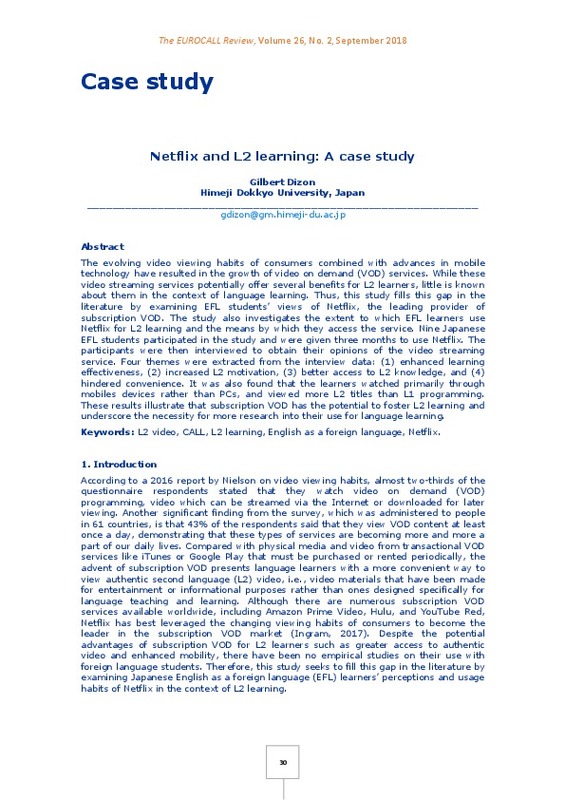Bardovi-Harlig, K. & Dörnyei, Z. (1998). Do language learners recognize pragmatic violations? Pragmatic versus grammatical awareness in instructed L2 learning. TESOL Quarterly, 32(2), 233-262. https://doi.org/10.2307/3587583.
Bianchi, F. & Ciabattoni, T. (2008). Captions and subtitles in EFL learning: An investigative study in a comprehensive computer environment. In A. Baldry, M. Pavesi, C. Taylor Torsello & C. Taylor (Eds.), From Didactas to Ecolingua: An Ongoing Research Project on Translation and Corpus Linguistics (pp. 69-80). Trieste: Edizonioni Università Trieste.
Chapple, L. & Curtis, A. (2000). Content-based instruction in Hong Kong: Student responses to film. System, 28(3), 419-433. https://doi.org/10.1016/S0346-251X(00)00021-X
[+]
Bardovi-Harlig, K. & Dörnyei, Z. (1998). Do language learners recognize pragmatic violations? Pragmatic versus grammatical awareness in instructed L2 learning. TESOL Quarterly, 32(2), 233-262. https://doi.org/10.2307/3587583.
Bianchi, F. & Ciabattoni, T. (2008). Captions and subtitles in EFL learning: An investigative study in a comprehensive computer environment. In A. Baldry, M. Pavesi, C. Taylor Torsello & C. Taylor (Eds.), From Didactas to Ecolingua: An Ongoing Research Project on Translation and Corpus Linguistics (pp. 69-80). Trieste: Edizonioni Università Trieste.
Chapple, L. & Curtis, A. (2000). Content-based instruction in Hong Kong: Student responses to film. System, 28(3), 419-433. https://doi.org/10.1016/S0346-251X(00)00021-X
Dörnyei, Z. (1998). Motivation in second and foreign language learning, Language Teaching, 31(3), 117135. https://doi.org/10.1017/S026144480001315X
Gardner, R.C. & Lambert, W. E. (1972). Attitudes and Motivation in Second-Language Learning. Newbury House: Rowley, MA.
Guichon, N. & McLornan, S. (2008). The effects of multimodality on L2 learners: Implications for CALL resource design. System, 36(1), 85-93. https://doi.org/10.1016/j.system.2007.11.005
Hays, P. (2004). Case study research. In K. de Marrais & S.D. Lapan (Eds.), Foundations for Research: methods of inquiry in education and social sciences (pp. 217- 234). London: Lawrence Erlbaum.
Hubbard, P. (2009). Computer assisted language learning: Critical concepts in linguistics (Vols. I-IV). London; New York: Routledge.
Ingram, M. (2017, March 10). Netflix is winning the streaming race - But for how long? Retrieved from http://fortune.com/2017/03/10/netflix-video-streaming-market.
Kasper, G. (1997). The role of pragmatics in language teacher education. In K. Bardovi-Harlig & B. Hartford (Eds.). Beyond methods (pp. 113-141). New York, NY: McGraw-Hill
King, J. (2002). Using DVD feature films in the EFL classroom. Computer Assisted Language Learning, 15(5), 509-523. https://doi.org/10.1076/call.15.5.509.13468
Lanvers, U. (2017). On the predicaments of the English L1 language learner: A conceptual article. International Journal of Applied Linguistics, 26(2), 147-167. https://doi.org/10.1111/ijal.12082
Lin, P.M.S. & Siyanova-Chanturia, A. (2014). Internet television for L2 vocabulary learning. In D. Nunan & J. C. Richards (Eds.), Language learning beyond the classroom (pp. 149-158). London: Routledge.
Lu, M. (2008). Effectiveness of vocabulary learning via mobile phone. Journal of Computer Assisted Learning, 24(6), 515-525. https://doi.org/10.1111/j.1365-2729.2008.00289.x
Markham, P.L., Peter, L.A. & McCarthy, J.T. (2001). The effects of native language vs. target language captions on foreign language students' DVD video comprehension. Foreign Language Annals, 34(5), 439-445. https://doi.org/10.1111/j.1944-9720.2001.tb02083.x
Masgoret, A.-M. & Gardner, R.C. (2003). Attitudes, motivation, and second language learning: A meta-analysis of studies conducted by Gardner and associates. Language Learning, 53(1), 167-210. https://doi.org/10.1111/1467-9922.00227
Mitterer, H. & McQueen, J.M. (2009). Foreign subtitles help but native-language subtitles harm foreign speech perception. PLoS ONE, 4(11), 1-5.
https://doi.org/10.1371/journal.pone.0007785
Molla, R. (2017, October 6). Netflix spends more than any other streaming service on content. Retrieved from https://www.recode.net/2017/10/6/16438078/netflix-amazon-hulu-hbo-spending-streaming-service.
Montero Perez, M., Peters, E., Clarebout, G., & Desmet, P. (2014). Effects of Captioning on Video Comprehension and Incidental Vocabulary Learning. Language Learning & Technology, 18(1), 118-141. http://dx.doi.org/10125/44357.
Nielson. (2016, March). Video on demand: How worldwide viewing habits are changing in the evolving media landscape. Retrieved from http://www.nielsen.com/content/dam/nielsenglobal/eu/docs/pdf/Nielsen-global-video-on-demand.pdf.
Netflix. (2017). Company Info: Overview. Retrieved October 31, 2017, from https://ir.netflix.com.
Qiang, N., Hai, T. & Wolff, M. (2007). China EFL: Teaching with movies. English Today, 23(2), 39-46. https://doi.org/10.1017/S0266078407002076
Stockwell, G. (2010). Using mobile phones for vocabulary activities: Examining the effect of the platform. Language Learning & Technology, 14(2), 95-110. http://llt.msu.edu/ vol14num2/stockwell.pdf.
Sydorenko, T. (2010). Modality of input and vocabulary acquisition. Language Learning & Technology, 14(2), 50-73. http://dx.doi.org/10125/44216.
Vandergrift, L. & Goh, C.C.M. (2012). Teaching and learning second language listening: Metacognition in action. New York, NY: Routledge. https://doi.org/10.4324/9780203843376
Walters, T. (2012). Understanding the "mobile shift": Obsession with the mobile channel obscures the shift to ubiquitous computing. Digital Clarity Group. Retrieved from http://digitalclaritygroup.com/wordpress/wp-content/uploads/2012/12/DCG-Insight-Understanding-the-Mobile-Shift-Nov-2012.pdf.
Winke, P., Gass, S. & Sydorenko, T. (2010). The effects of captioning videos used for foreign language listening activities. Language Learning & Technology, 14(1), 65-86. http://dx.doi.org/10125/44203.
[-]







![HTML file [HTML]](/themes/UPV/images/html.png)

